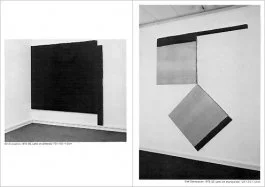Städtische Galerie 1981
Division – Displacement – Accumulation
by Marcelin Pleynet
Today our relationship with art production cannot avoid acknowledging, in one manner or another, the multiplicity of experiences which have marked modern art and, in consequence, contemporary art. These experiences assert themselves through a certain number of works which, at this point, given the relative extent of our knowledge of them, contribute to the development of our culture. It is true that these experiences and the works through which they emerge are often still so close to us that our tendency is to see them only in terms of their materials, techniques and forms. A large part of modern art fixes our attention on materials and techniques rather than on the artists’ insight, conveyed by the specific qualities of their work their manner of thinking and perceiving the vital questions of art and modern culture.
Not the least of the qualities to be found in the work of Michael Gitlin is that it embraces the accumulation of contemporary art’s formal experiences and gives them intelligence, dimension and measure. In short, Michael Gitlin’s work engages the general context of modern culture rather than an eclectic accumulation of avant-garde eccentricities. In 1978 I underlined the complex relationship between drawing and sculpture in this artist’s work, brought to our attention by Yona Fischer in the preface to the catalogue of Michael Gitlin’s exhibition at the Israel Museum of Jerusalem. I think we must add to this proposition, and the recent pieces show this beyond question, the pictorial dimension which, in my opinion, is at the origin of the artist’s inspiration and the outcome of his work. Whichever of Michael Gitlin’s pieces that one considers, apart from its obvious aesthetic and plastic realization, one is immediately drawn visually and intellectually into a process which develops, to borrow one of Mark Rothko’s formulations, “the complex idea in simple terms.“ Michael Gitlin’s works make use of a dynamic, in the logic and organization of masses, which, in first instance, involves visual experience in the reconstruction, based on the elements given by the artist, of the process of each piece’s material creation, and in second instance of the creative process itself. In this way, each piece proposes a visual experience at the level of its construction, such that, little by little, it attunes and cultivates the attracted eye to the order of intellectual and perceptual experience which lends it aesthetic dimension.
I will select three stages in the overall experience that each work by Michael Gitlin presents. The first perception of the work in a dynamic engagement of its construction and its realization. The formal references, both theoretical and cultural on which the material’s utilization and organization are based. The qualities and the plastic consequences of the process taken in its entirety.
If we try to define the mode of functioning of Michael Gitlin’s pieces in a way that engages the dynamic of their construction, we notice that for the most part, in the first instance, that is to say in the pieces dated between 1974 and 1977, the artist operates by division and displacement. An ensemble such as “Rotation“ (1977) composed of four pieces equally broken up or divided at the centre and turning the pieces’ torn edges around this center of gyratory displacement, is highly indicative of this first mode of organization. From 1977 up until and including the present day Michael Gitlin has drawn the logical consequences from this first mode of operation by division and displacement through accentuating its immediate consequence, accumulation. The division of an initial element (most often a piece of wood with at least one of its faces painted) produced an effect of multiplication (most often one into two; or four times one into two in the case of “Rotation“) which, involved in the unity of the works, operates inevitably by accumulation. From this point of view it seems to me that “Rotation“ plays a highly significant role (both didactic and theoretical) in Michael Gitlin’s work. Without, of course, any desire to generalize, we can say that the dynamic of the large majority of the pieces is connected to the rotation of one of their elements, and that the efficacy of their action on the viewer’s perception depends on this rotation almost always taking place in a displacement from left to right (for “Demarcation I“ (1976), “Rotation“ (1977), “Transition“, “Extended Line“, “Small problem piece“ (1979) and “White Obstacle“ (1980) among others) reproducing the reading reflex in occidental languages. The group of pieces in 1979 which Michael Gitlin called “Transition“ is very indicative of the success of the operation by division, displacement, accumulation. The element taken from the left part of the pieces rotates so as to double over the right part, transforming the horizontality of the initial unity into a formal complex: objective and consequence of the operation.
This first approach allows us to understand Michael Gitlin’s practical position, and from this point of view the system of manipulation, of displacement and transformation of the initially chosen material, illustrates the artist’s theoretical position. If the division of the wood piece’s initial unity operates, in terms of the decision which determines it, an ensemble of formal transformations caught up in the arbitrary logic which directs them, the artist’s intervention as such tends to produce the same kind of phenomenon in the cultural context which he acknowledges, appropriates, and dissolves with a transformation following the same pattern: by division (every particular and individual intervention has the tendency to divide the cultural unity in which it is installed); displacement (once divided, the cultural order has the tendency to assume the forces producing this division and to constitute itself, by a displacement of some of its elements, in a new unitary structure); accumulation (once achieved, the transformation inevitably produces, both quantitively and qualitively, a new dimension through its addition to the initial quantity).
I insist on how Michael Gitlin’s work functions systematically so as to draw the observer’s attention to all its constitutive elements. If we recognize the creative logic presiding over the realization of this work, we cannot avoid the suspicion that each of its elements plays an essential role. In this connection, I would like to return to the complex relationship established by Michael Gitlin’s work between drawing, sculpture and painting, that I suggested at the beginning. I was immediately struck, when considering the pieces dated 1974–1977, by the torn line’s role resulting from the division by rupture of an initial unity. We see this quite clearly in a piece like “Rotation” (1977) which systematically presents all the stages of this play of straight, sharp, and broken lines as it is to be found in the inversion (back/front) in “Black to the Wall II” (1977). This broken line in the arrangement of “Rotation’s” four elements provides a drawing which, at the same time, insists on the real thickness of the material making up the piece. In other words, the three dimensional character of Michael Gitlin’s work tends, through the drawing, to integrate itself with the specifically pictorial qualities of their frontality. The play here between relief and frontality comes from a drawing (and a form underlying the drawing) which tends to integrate in the order of the plastic operation all its constituent elements up to and including the arbitrary and random elements of the artist’s subjective intervention. This erratic line and the often dual character of the pieces, the inclusion of the more or less random expressive elements of the artist’s intervention on his chosen material, are not without evoking, in the formal order given to them by Michael Gitlin, more or less explicitly referential relations with the history of modern painting and, notably, a consideration of the questions still raised today by the “subjects of the artist” of the first generation of American artists. A situation in which Michael Gitlin would seem to have adapted, if not adopted, the position of Barnett Newman. It is impossible not to see, in Michael Gitlin’s manner of using the line which separates the elements presented, an explicit reference to the “zip” and its role in Barnett Newman’s paintings. It is well known that on the surface the “zip” employs the thickness of the canvas as a negation of the surface and that one of the consequences was “Here I”, a three-dimensional piece, sculpture in two vertical lines, in which the torn line of the zip and the plain line of the picture’s edge demonstratively state their role. In this way Michael Gitlin’s work refers explicitly to Newman’s enterprise and the consequences which it implies for modern and contemporary art, radicalizing and, without the suggestion of a denial, overturning (by division and displacement) its critical modes. It is no longer only the support (the canvas, the picture) that is demonstrated, but the whole creative act surrounded by all the elements which determine it. Justifying, rationalizing, and demonstrating all the elements which constitute his work, Michael Gitlin produces a 180° rotation (notably with “Demarcation I”) in which all the elements of each piece (left/right, front/back, above/below, frontality/volume, line, colour, drawing) are made clearly explicit, thus demonstrating what obviously amounts qualitively to an accumulation. It is the only decision of the artist who, in an always random and arbitrary manner, bestows on the elements of his work (no matter which elements these may be) their artistic dimension. A continuously unexpected act of great reconciliative violence which cannot fail to fascinate us in the simplicity and the force of the pieces which realize it.


